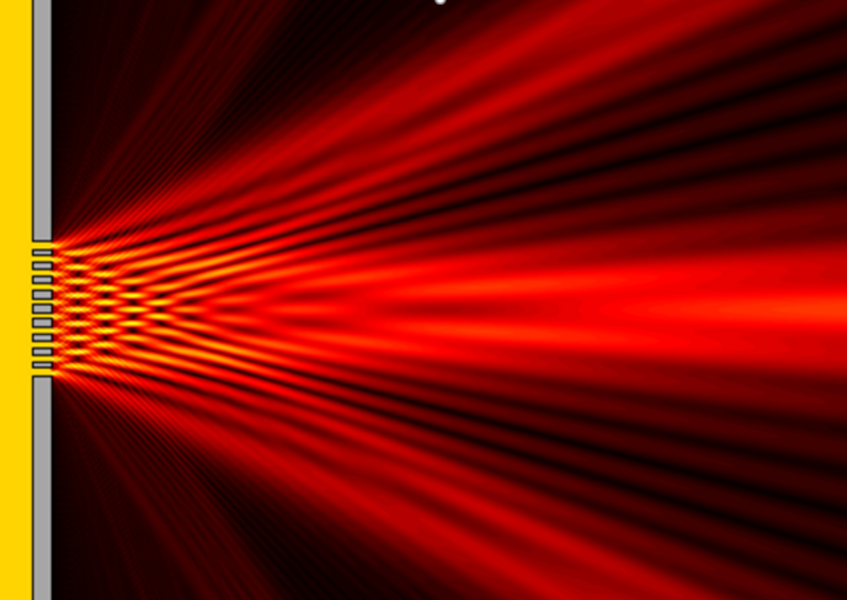Talbot-Lau Interferometry: Coherent Imaging in the Near-field

Talbot-Lau Interferometry: Coherent Imaging in the Near-field
We differentiate between near-field and far-field physics to distinguish wave phenomena close to or far away from the diffracting aperture of typical extension A. The distinctive range is the "Aperture Talbot Length" LA=A2/λ.
When a periodic transmission mask is illuminated by a plane wave, coherent wave propagation in the near-field causes a periodic self-imaging of the transmission mask, as shown in the figure for the first 10 Talbot lengths.
These recurrences would proceed for ever, if the plane wave and the diffraction mask were both infinitely extended. The finite size of the aperture causes the diffraction into the well-known far-field fringe pattern, many Talbot lengths further downstream. Note: the relevant quantity in this transition is the Talbot length of the field-constraining aperture, not of the diffraction grating.
Talbot-Lau interferometry: Coherent imaging with incoherent sources
In the absence of well-defined plane waves - as is the case for thermal atomic or molecular beams but also in X-ray optics - Talbot self-imaging can still be realized by preparing the required coherence in situ. The idea goes back to E. Lau and consists in using two gratings instead of one. The first grating will act as an array of narrow slit sources which then provide sufficient spatial confinement to illuminate the second grating coherently.
In comparison to the double slit experiment, near-field matter-wave interferometry offers
- Orders of magnitude higher transmission
- Compatibility witih spatially incoherent sources
- A wide acceptance range with regard to velocity, mass and de Broglie wave
- Higher sensitivity to external forces
- Shorter devices.
This potential has already been seen by John Clauser, who realized the first Talbot-Lau interferometer with potassium atoms [1] and also formulated the dream to use this concept for 'little rocks and live viruses' [2].
And even though it turns out that many adaptations have to be made to the original concept to achieve this goal, near-field interferometry is one of the most powerful methods in the coherent manipulation of complex and high-mass clusters and macromolecules.
In Vienna we were the first to realize a complete matter-wave interferometer for molecules[3], and also this device was based on the TL effect. The same design was then used to implement collisional [4] and thermal [5] decoherence experiments as well as to demonstrate the first matter-wave interference of the bio-dye derivative tetraphenylporphyrin [6].
Talbot-Lau interferometry generates fringe patterns the period of which is largely unaffected by the de Broglie wavelength. However, the contrast varies strongly with it and is a tell-tale sign allowing the quantitative distinction between quantum effects and classical Moiré patterns.
These fringe patterns are free-flying nanostructures in high vacuum, which may however also be captured on an atomically clean silicon surface: we call this matter-wave assisted molecule lithography [7]
References
- E. Lau, Beugungserscheinungen an Doppelrastern, Ann. Phys. 6, 417 (1948).
- J.F. Clauser, S. Li, Talbot-von Lau atom interferometry with cold slow potassium, Phys. Rev. A 49, R2213 (1994).
- J.F. Clauser, De Broglie-wave interference of small rocks and live viruses, in: R.S. Cohen, M. Horne, J. Stachel (Eds.)
Experimental Metaphysics, Kluwer Academic, 1997, pp. 1-11. - B. Brezger, L. Hackermüller, S. Uttenthaler, J. Petschinka, M. Arndt, A. Zeilinger,
Matter-Wave Interferometer for Large Molecules,
Phys. Rev. Lett. 88, 100404 (2002). - K. Hornberger, S. Uttenthaler, B. Brezger, L. Hackermüller, M. Arndt, A. Zeilinger,
Collisional Decoherence Observed in Matter Wave Interferometry,
Phys. Rev. Lett. 90, 160401 (2003). - L. Hackermüller, K. Hornberger, B. Brezger, A. Zeilinger, M. Arndt,
Decoherence of matter waves by thermal emission of radiation,
Nature 427, 711-714 (2004). - L. Hackermüller, S. Uttenthaler, K. Hornberger, E. Reiger, B. Brezger, A. Zeilinger, M. Arndt,
Wave Nature of Biomolecules and Fluorofullerenes,
Phys. Rev. Lett. 91, 090408 (2003). - T. Juffmann, S. Truppe, P. Geyer, S. Deachapunya, H. Ulbricht and M. Arndt
Wave and Particle in Molecular Interference Lithography
Phys. Rev. Lett. 103, 263601 (2009).
